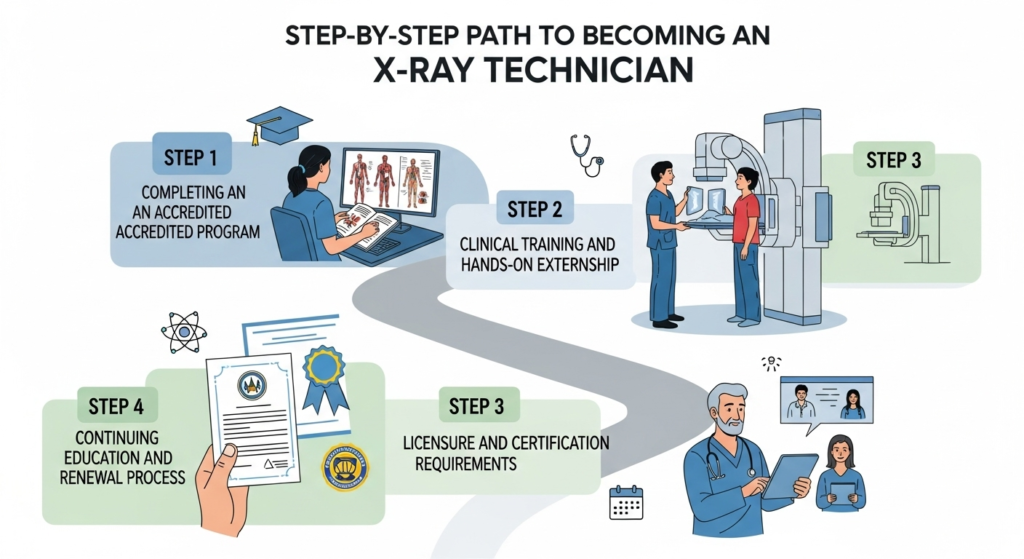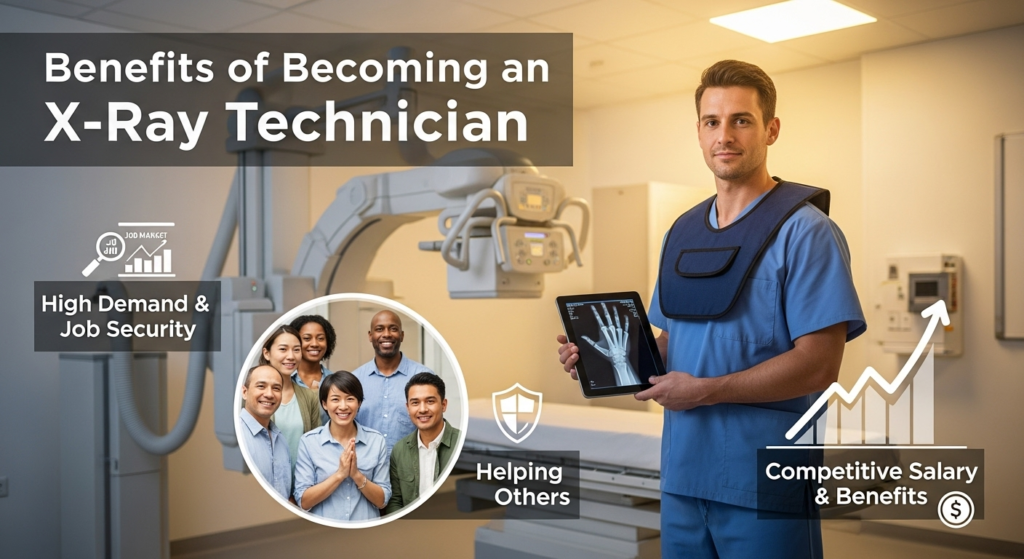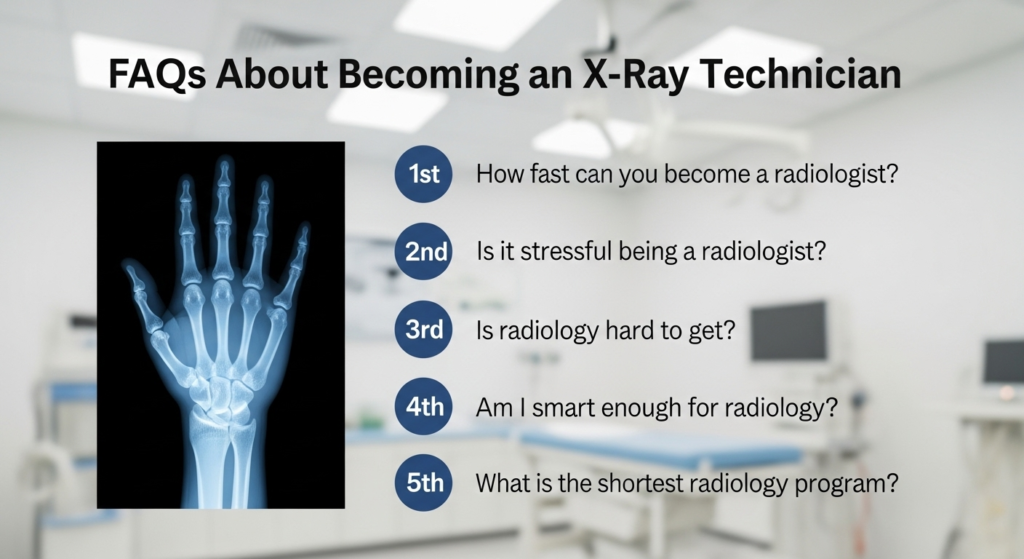If you’ve ever had an X-ray at the doctor’s office or hospital, you’ve met the healthcare professional behind the machine: an X-ray technician, also called a radiologic technologist. Many people interested in healthcare wonder, how long does it take to become an X-ray tech? The answer usually depends on the type of program you choose and the career path you want to follow.
Most students complete their training in about two years, but faster and longer options are available. This guide will explain what X-ray techs do, how long the training takes, and what you can expect from this rewarding career..
- What Is an X-Ray Technician (Radiologic Technologist)?
- Education and Training Requirements
- Step-by-Step Path to Becoming an X-Ray Technician
- Timeline – How Long Does It Take?
- Cost and Financing Options
- Career Opportunities and Job Outlook
- Comparing Training Options
- Benefits of Becoming an X-Ray Technician
- Additional Resources for Aspiring X-Ray Technicians
- FAQs About Becoming an X-Ray Technician
- Conclusion
What Is an X-Ray Technician (Radiologic Technologist)?
An X-ray technician, also known as a radiologic technologist, is a healthcare worker who uses imaging equipment to help doctors look inside the human body. They perform X-rays, prepare patients for imaging, and follow safety rules to protect people from too much radiation.
Some people confuse an X-ray technician with a radiologist. A radiologist is a medical doctor who interprets images and makes diagnoses. An X-ray technician takes the images but does not decide what they mean. Knowing this difference is important when you plan your career path.
Education and Training Requirements
The first step toward becoming an X-ray technician is completing the right education. Most employers require at least an associate degree in radiologic technology. Let’s look at the main options.
High School Preparation
High school students who want to pursue this career should focus on science and math. Courses in biology, anatomy, and physics can help. Good grades make it easier to get into accredited radiology technician schools.
Associate Degree in Radiologic Technology
The most common path is a two-year associate degree in radiography. Accredited radiography programs cover anatomy, radiation safety and physics coursework, patient care, and equipment operation. Many of these programs also include clinical rotations in radiology, where you work directly with patients under supervision.
Certificate and Accelerated Programs
Some schools offer certificate programs that take about 12 to 18 months. These are faster but less common. They may be an option if you already work in healthcare or want to train quickly.
Online vs On-Campus Training Programs
Today, many schools offer online or hybrid radiologic technologist training programs. Online classes cover theory, while clinical externship radiography must be completed in person. Hybrid learning gives flexibility, but you should make sure the program has proper accreditation.
Step-by-Step Path to Becoming an X-Ray Technician

Training to become an X-ray tech follows a series of steps.
Completing an Accredited Program
Choose an accredited program that meets standards set by the Joint Review Committee on Education in Radiologic Technology (JRCERT). Accreditation matters because it makes you eligible for certification.
Clinical Training and Hands-On Externship
During your program, you will complete hands-on learning in radiology through externships or clinical rotations. This real-world practice is essential for gaining confidence.
Licensure and Certification Requirements
After graduation, most states require licensure. You will likely need to pass the American Registry of Radiologic Technologists (ARRT) exam. ARRT certification eligibility depends on completing an accredited program and meeting exam requirements.
Continuing Education and Renewal Process
Licenses and certifications must be renewed regularly. Continuing education ensures that X-ray techs stay updated with the latest technology and safety standards.
Timeline – How Long Does It Take?
Most students finish training in about two years through an associate degree in radiologic technology.
Certificate programs may be completed in as little as 12 to 18 months. Hybrid programs can also shorten or extend the timeline depending on the pace.
Some schools, such as Fortis College, advertise radiologic technologist education timelines as short as 96 weeks. This shows that training can be flexible depending on the program structure and your schedule.
Cost and Financing Options
The cost of X-ray technician programs varies widely. Community college programs may cost less, while private schools can be more expensive. The average cost can range from $6,000 to over $20,000 for a full program.
Financial aid is available through federal student loans, grants, and scholarships. Some employers may also offer tuition reimbursement.
The return on investment is usually strong because the career has steady demand and a solid salary outlook. According to the U.S. Bureau of Labor Statistics, radiologic technologists earned a median annual salary of about $67,000 in 2023, with higher pay in hospitals and outpatient centers.
Career Opportunities and Job Outlook
After training, X-ray technicians can specialize in areas like mammography, CT scans, or nuclear medicine. Specializations often lead to higher pay and more career advancement opportunities.
The job outlook is positive. The Bureau of Labor Statistics projects steady radiologic technologist job growth in the coming years, especially as the population ages.
Beyond growth, many techs appreciate the work-life balance. Shifts vary, and while hospitals can be busy, outpatient clinics often have regular hours.
Comparing Training Options
Choosing between online and on-campus programs depends on your lifestyle. On-campus programs give more direct contact with instructors, while online or hybrid programs allow flexibility.
When picking a school, look for accredited radiology technician training programs that provide job placement support and strong clinical experience.
If you decide radiography is not right for you, there are related paths such as sonography, MRI technology, or radiation therapy. These careers also require specialized training but share similar foundations.
Benefits of Becoming an X-Ray Technician

There are many benefits to becoming an X-ray tech. Salaries are competitive, especially for those with special skills or advanced certifications. The field offers high job stability since imaging is essential in healthcare.
Professional development is encouraged through continuing education, and many techs enjoy being part of a medical team that helps patients every day.
Additional Resources for Aspiring X-Ray Technicians
Professional associations such as the American Society of Radiologic Technologists (ASRT) and the ARRT offer resources, continuing education, and career support.
The latest trends in radiology include advances in digital imaging and new safety technologies. For those who may want a career change later, the skills gained can also transfer to related healthcare careers.
FAQs About Becoming an X-Ray Technician

What is the quickest way to become an X-ray tech?
The fastest way is through a certificate program, which may take 12 to 18 months. However, most people choose the two-year associate degree because it offers more job opportunities.
How long does it usually take to become an X-ray tech?
On average, it takes about two years to complete an associate degree in radiologic technology. Accelerated programs may be shorter.
Is being an X-ray technician stressful?
It can be stressful at times, especially in emergency settings. But many techs find the job rewarding because they help doctors and patients in important ways.
Is radiology hard to get into?
Programs can be competitive, but good grades in science and math improve your chances. Accredited schools may require placement tests or interviews.
What is the shortest radiology program available?
The shortest programs are certificates that can be completed in 12 to 18 months. Most employers still prefer an associate degree.
Conclusion
So, how long does it take to become an X-ray tech? For most people, the journey takes about two years with an associate degree, though quicker options exist. With the right education, licensure, and certification, you can start a stable and rewarding career in healthcare.
If you want to explore further, you can check trusted resources like the Bureau of Labor Statistics and the ARRT for official career and certification details.






